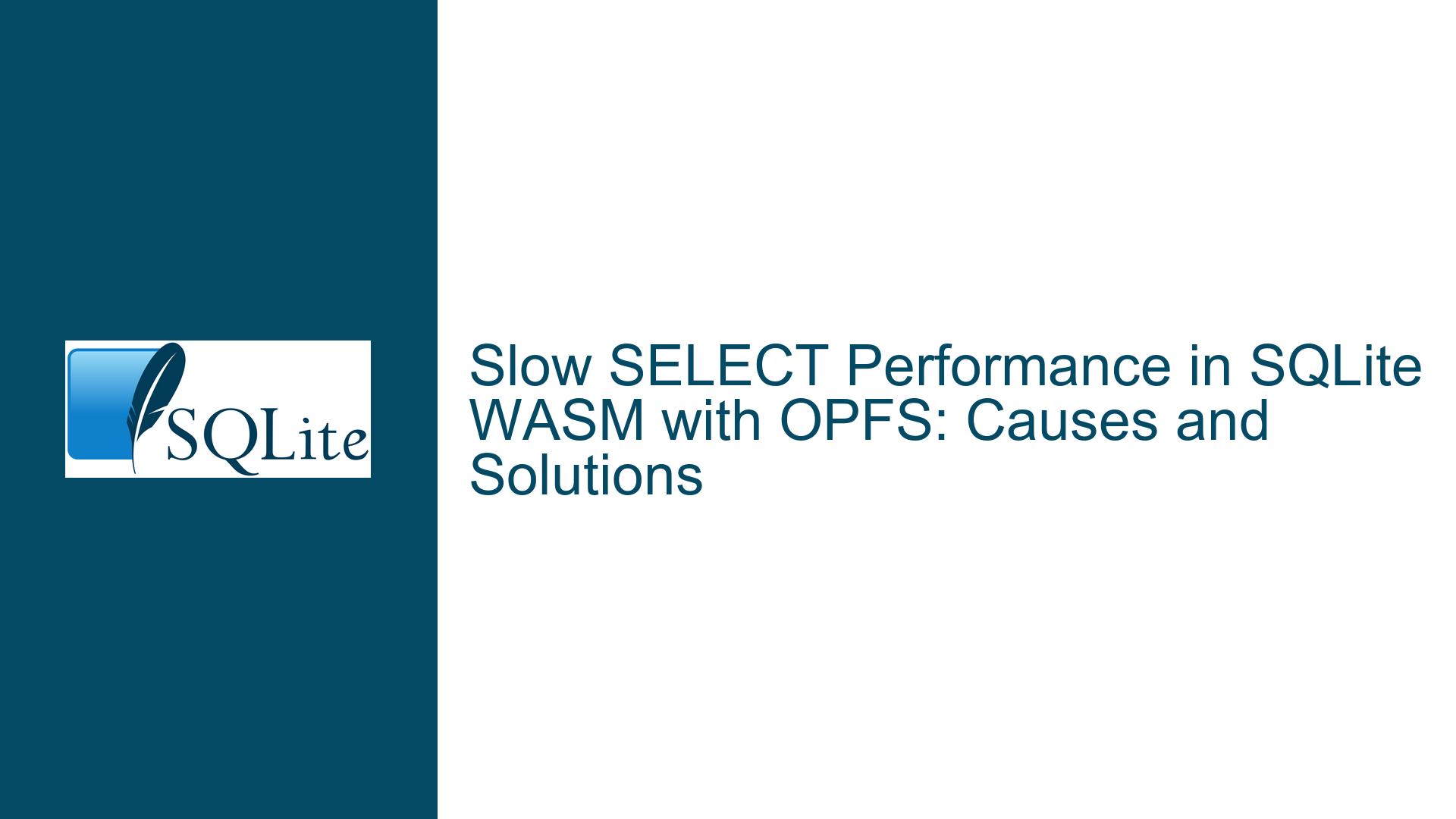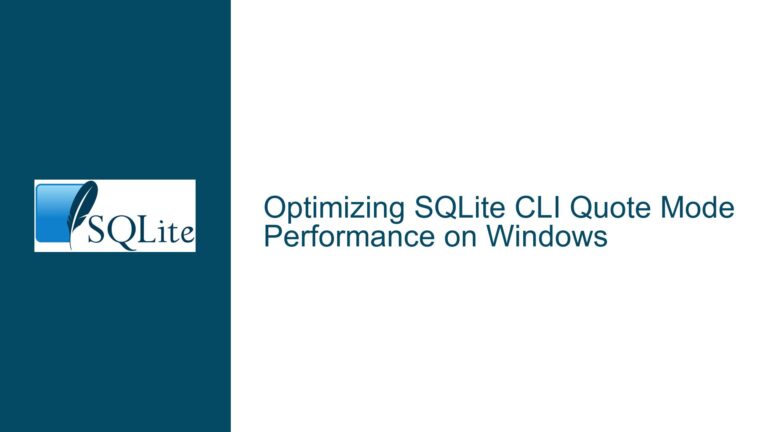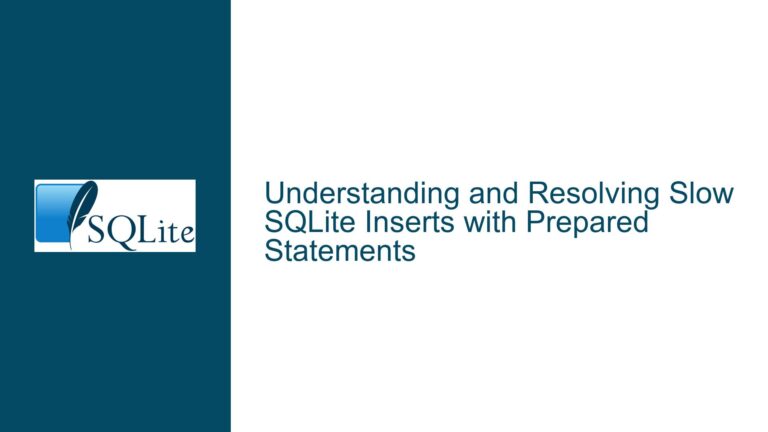Slow SELECT Performance in SQLite WASM with OPFS: Causes and Solutions
Understanding the Performance Bottlenecks in SQLite WASM with OPFS
When working with SQLite in a web environment using WebAssembly (WASM) and the Origin Private File System (OPFS), one of the most common performance issues developers encounter is slow SELECT query execution, even on empty tables. This issue is particularly perplexing because it contrasts sharply with the performance benchmarks seen in native SQLite implementations. To understand why this happens, we need to delve into the architecture of SQLite WASM, the role of OPFS, and the inherent limitations of browser-based environments.
The primary bottleneck lies in the asynchronous nature of OPFS and the communication overhead between JavaScript and WebAssembly. SQLite, being a synchronous database engine, relies on synchronous I/O operations for optimal performance. However, OPFS, designed for web applications, operates asynchronously. This mismatch forces SQLite WASM to jump through several hoops to bridge the gap, introducing significant latency. Additionally, the cross-thread communication boundaries in JavaScript engines further exacerbate the issue, as the database engine must wait for these asynchronous operations to complete before proceeding with query execution.
Another factor contributing to the slow SELECT performance is the overhead introduced by the JavaScript-to-WASM boundary. Every query execution involves marshaling data between JavaScript and WebAssembly, which adds latency. This is especially noticeable in web environments where the performance characteristics differ significantly from native applications. The browser’s event loop, garbage collection, and other background tasks can further delay query execution, making it difficult to achieve the same performance levels as native SQLite.
Exploring the Role of OPFS and Browser-Specific Limitations
The Origin Private File System (OPFS) is a key component in enabling persistent storage for web applications. However, its design choices have a direct impact on SQLite WASM’s performance. OPFS is inherently asynchronous, which means that every file operation, including reads and writes, must be handled asynchronously. This design choice was made to align with the asynchronous nature of JavaScript and web APIs, but it introduces significant challenges for SQLite, which expects synchronous I/O operations.
In the context of SQLite WASM, the asynchronous nature of OPFS forces the database engine to wait for each I/O operation to complete before proceeding. This waiting period is further extended by the cross-thread communication delays inherent in JavaScript engines. For example, when a SELECT query is executed, SQLite WASM must wait for the OPFS API to return the requested data, which can take several milliseconds due to the asynchronous nature of the API and the communication overhead.
Browser-specific implementations of OPFS also play a role in the performance discrepancies observed. Different browsers handle OPFS operations differently, leading to varying performance characteristics. For instance, some browsers may optimize certain operations better than others, resulting in faster query execution times. Additionally, browser updates and changes to the OPFS API can introduce new performance bottlenecks or improvements, making it difficult to predict and optimize for consistent performance across all environments.
Optimizing SELECT Performance in SQLite WASM with OPFS
To address the slow SELECT performance in SQLite WASM with OPFS, several strategies can be employed. One approach is to minimize the number of cross-thread communication operations by batching queries or using transactions. By grouping multiple queries into a single transaction, the database engine can reduce the number of times it needs to wait for OPFS operations to complete, thereby improving overall performance.
Another strategy is to leverage in-memory databases for read-heavy workloads. In-memory databases eliminate the need for file I/O operations, allowing SQLite to execute queries much faster. However, this approach is only feasible for temporary data or scenarios where persistence is not required. For persistent storage, developers can use a hybrid approach, where frequently accessed data is cached in memory while less frequently accessed data is stored in OPFS.
Optimizing the JavaScript-to-WASM communication layer is also crucial for improving SELECT performance. Developers can reduce the overhead of data marshaling by minimizing the amount of data transferred between JavaScript and WebAssembly. This can be achieved by using efficient data structures and avoiding unnecessary data conversions. Additionally, using prepared statements and parameterized queries can help reduce the overhead of query preparation and execution.
Finally, staying informed about browser updates and changes to the OPFS API is essential for maintaining optimal performance. Browser developers are continually working on improving the performance of web APIs, and new optimizations may become available in future updates. By keeping up with these developments, developers can take advantage of new features and optimizations to further enhance the performance of SQLite WASM with OPFS.
In conclusion, while slow SELECT performance in SQLite WASM with OPFS can be challenging to address, understanding the underlying causes and employing targeted optimization strategies can significantly improve query execution times. By minimizing cross-thread communication, leveraging in-memory databases, optimizing the JavaScript-to-WASM communication layer, and staying informed about browser updates, developers can achieve better performance and deliver a smoother user experience in their web applications.






